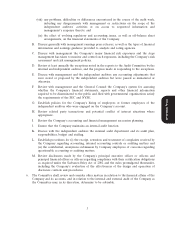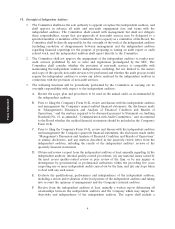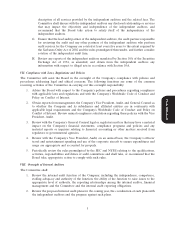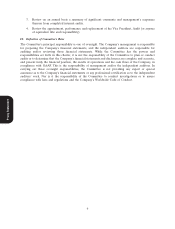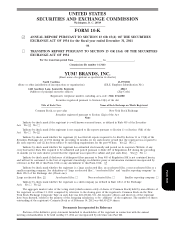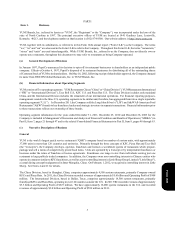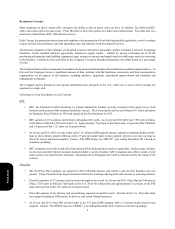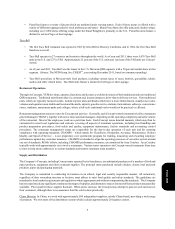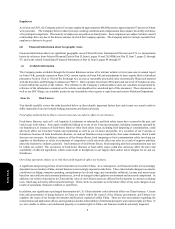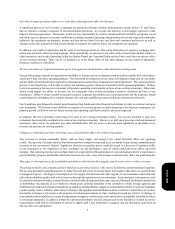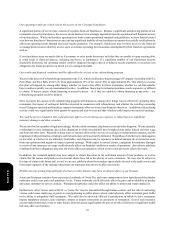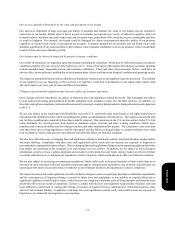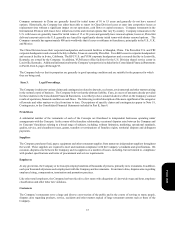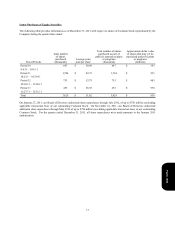Pizza Hut 2011 Annual Report Download - page 111
Download and view the complete annual report
Please find page 111 of the 2011 Pizza Hut annual report below. You can navigate through the pages in the report by either clicking on the pages listed below, or by using the keyword search tool below to find specific information within the annual report.
7
and location of competing food retailers and products; and disposable purchasing power. Each of the Concepts competes with
international, national and regional restaurant chains as well as locally-owned restaurants, not only for customers, but also for
management and hourly personnel, suitable real estate sites and qualified franchisees. Given the various types and vast number
of competitors, our Concepts do not constitute a significant portion of the retail food industry in terms of number of system units
or system sales, either on a worldwide or individual country basis.
Research and Development (“R&D”)
The Company’s subsidiaries operate R&D facilities in Shanghai, China (China Division); Dallas, Texas (Pizza Hut U.S. and YRI);
Irvine, California (Taco Bell); Louisville, Kentucky (KFC U.S.) and several other locations outside the U.S. The Company
expensed $34 million, $33 million and $31 million in 2011, 2010 and 2009, respectively, for R&D activities. From time to time,
independent suppliers also conduct research and development activities for the benefit of the YUM system.
Environmental Matters
The Company is not aware of any federal, state or local environmental laws or regulations that will materially affect its earnings
or competitive position, or result in material capital expenditures. However, the Company cannot predict the effect on its operations
of possible future environmental legislation or regulations. During 2011, there were no material capital expenditures for
environmental control facilities and no such material expenditures are anticipated.
Government Regulation
U.S. Division. The Company and its U.S. Division are subject to various federal, state and local laws affecting its business. Each
of the Concepts’ restaurants in the U.S. must comply with licensing and regulation by a number of governmental authorities, which
include health, sanitation, safety, fire and zoning agencies in the state and/or municipality in which the restaurant is located. In
addition, each Concept must comply with various state and federal laws that regulate the franchisor/franchisee relationship. To
date, the Company has not been materially adversely affected by such licensing and regulation or by any difficulty, delay or failure
to obtain required licenses or approvals.
The Company and each Concept are also subject to federal and state laws governing such matters as immigration, employment
and pay practices, overtime, tip credits and working conditions. The bulk of the Concepts’ employees are paid on an hourly basis
at rates related to the federal and state minimum wages. The Company has not been materially adversely affected by such laws
to date.
The Company and each Concept are also subject to federal and state child labor laws which, among other things, prohibit the use
of certain “hazardous equipment” by employees younger than 18 years of age. The Company has not been materially adversely
affected by such laws to date.
The Company and each Concept are also subject to laws relating to information security, privacy, cashless payments, and
consumer credit, protection and fraud. The Company has not been materially adversely affected by such laws to date.
The Company and each Concept are also subject to laws relating to nutritional content, nutritional labeling, product safety and
menu labeling. The Company has not been materially adversely affected by such laws to date.
The Company and each Concept, as applicable, continue to monitor their facilities for compliance with the Americans with
Disabilities Act (“ADA”) in order to conform to its requirements. Under the ADA, the Company or the relevant Concept could
be required to expend funds to modify its restaurants to better provide service to, or make reasonable accommodation for the
employment of, disabled persons. The Company has not been materially adversely affected by such laws to date.
International and China Divisions. The Company’s restaurants outside the U.S. are subject to national and local laws and
regulations which are similar to those affecting U.S. restaurants, including laws and regulations concerning information security,
labor, health, sanitation and safety. The restaurants outside the U.S. are also subject to tariffs and regulations on imported
commodities and equipment and laws regulating foreign investment. International compliance with environmental requirements
has not had a material adverse effect on the Company’s results of operations, capital expenditures or competitive position.
See Item 1A "Risk Factors" on page 8 for a discussion of risks relating to federal, state, local and international regulation of our
business.
Form 10-K


